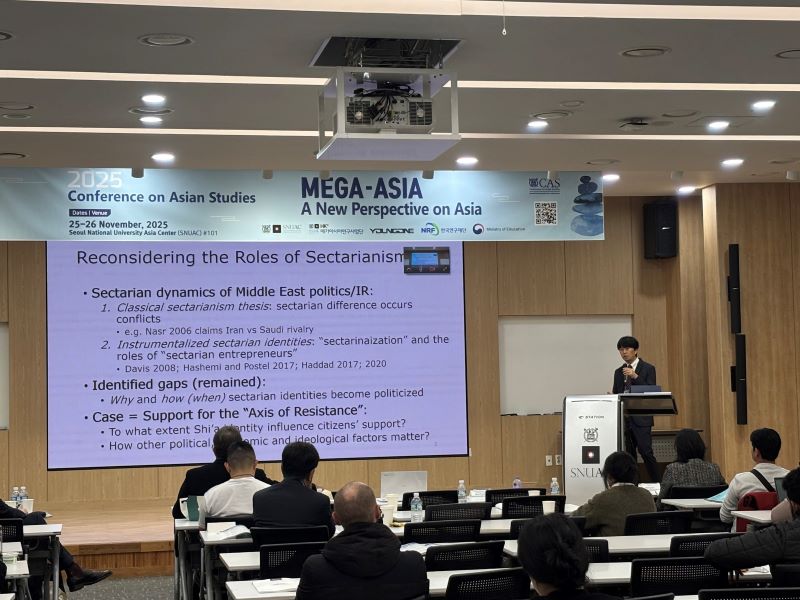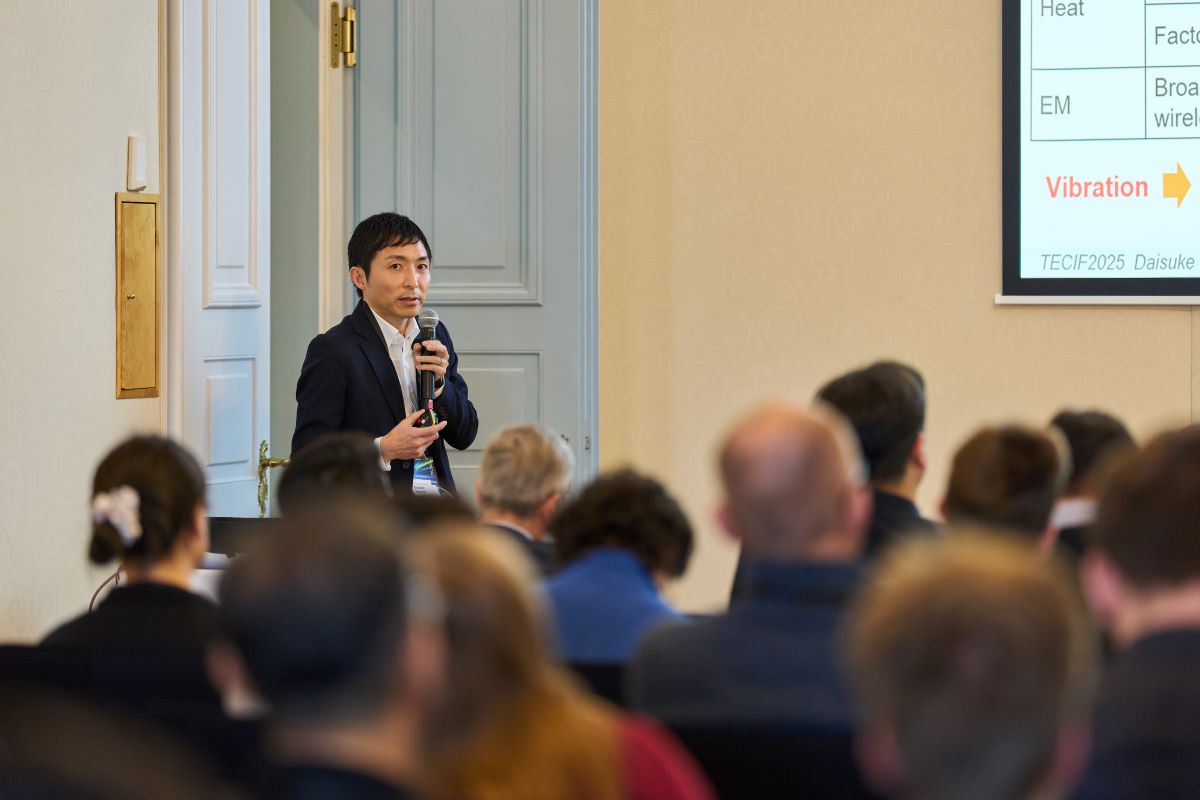Newsletter / Research Activity Report / Takashi Minemoto
RARA Newsletter vol. 7 Perovskite Solar Cell Research in the Spotlight. Contributing to Decarbonization as an Expert. ──Interview with Professor Takashi Minemoto (RARA Fellow)
2024 / 08 / 30

2024 / 08 / 30
Taking up the challenge of commercializing ‘perovskite solar cells’ that are rapidly drawing attention
In this issue of the Newsletter, we present an interview with the RARA Fellow Takashi Minemoto, Professor, College of Science and Engineering, who is engaged in research on solar cells to convert sunlight into electricity.
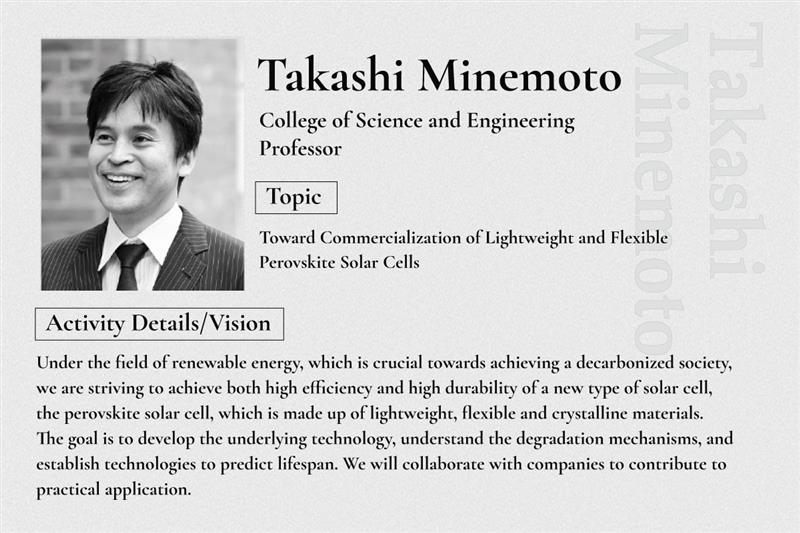
Professor Minemoto’s research topic is “Toward Commercialization of Lightweight and Flexible Perovskite Solar Cells.”
The development and expansion of renewable energy are crucial for the realization of a decarbonized society. Photovoltaic power generation is a representative candidate of a renewable energy source, and its progress and development are expected to continue. However, Japan has relatively little flat land due to its mountainous terrain, so there are constraints to installing photovoltaic power generation facilities.
This is the reason why ‘perovskite solar cells’, the focus of Professor Minemoto’s research, are currently drawing attention. Perovskite solar cells can be easily produced by simply ‘coating and drying’ and can even be printed. They are lightweight and flexible, so they can possibly be installed on curved surfaces such as walls and cars, which would have been difficult using previous methods, and are expected to be a powerful option for expanding the introduction of renewable energy.
The government also focuses on their development, and companies are engaged in research and development, demonstration experiments, and fundraising. In order to achieve early commercialization, the Green Innovation Project under the New Energy and Industrial Technology Development Organization (NEDO) provides large subsidies for social implementation. Perovskite solar cells has become a hot topic, with related news emerging daily.
Starting a business venture, managing a YouTube channel, and collaborating with researchers at other universities
Professor Minemoto is the founder and representative director of Scholars Co., Ltd., a Ritsumeikan University business venture. University professors and researchers active at the forefront provide support to companies working on R&D and new business development related to photovoltaic power generation and renewable energy.
Over the past 4 years, he has also been managing a YouTube channel called “PhotoVoltaics University,” where he creates videos explaining the latest research, business, and future within the field of photovoltaics, in collaboration with researchers from across Japan.
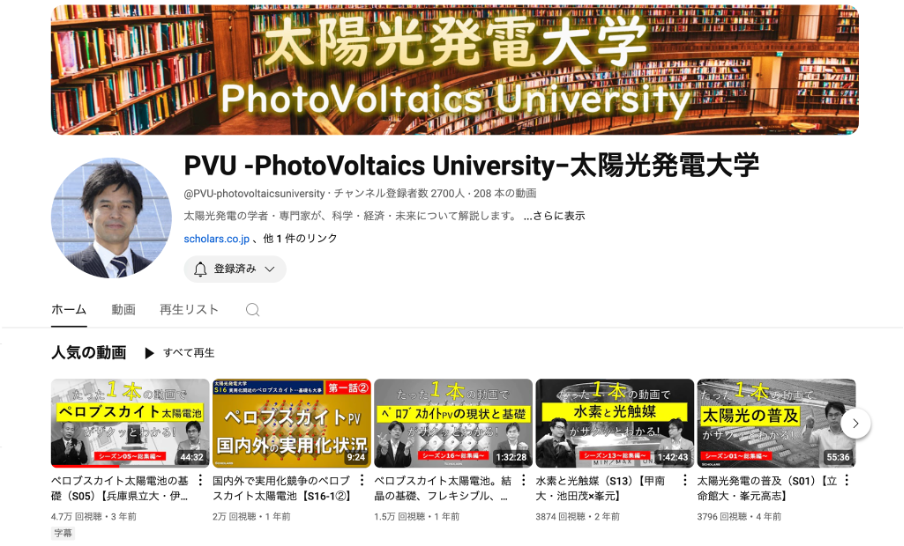
The YouTube channel “PVU -PhotoVoltaics University−太陽光発電大学” is operated by Professor Minemoto. Popular lecture videos have approximately 50,000 views.
How exactly do perovskite solar cells, which are experiencing a rapid upsurge, differ from conventional solar cells, and what is their potential? What are the thoughts of Professor Minemoto and the driving forces behind his research and outreach activities related to solar cells?
(The following is a summary composed by the writer based on a conversation with Professor Minemoto)
Although Japan was in the lead in terms of research on crystalline silicon, China dominated the market in terms of production and business. The issue of degradation of amorphous silicon could not be solved.
First, why is it that perovskite solar cells are attracting attention now? Let me tell you about the background and history.
Current mainstream solar cells are “crystalline silicon” solar cells. Originally, Japan had the technology to produce high-performance crystalline silicon, but China began to produce it inexpensively and in large quantities. The introduction of the solar cell module production system (turnkey system), which was developed in Europe, has allowed China to accelerate mass production.
Although China relied on the turnkey system initially, its technological capabilities increased gradually and promoted high performance based on national policy. In addition, government subsidies enabled crystalline silicon solar cells to be manufactured at low costs, which resulted in China taking the lead in terms of manufacturing.
Even though Japan pioneered the study of crystalline silicon, China became the dominant country in terms of its manufacturing and business.
As an alternative to crystalline silicon, which has a thickness of approximately 0.2 millimeters, Japan focused on research into solar cells using thin-film silicon or ‘amorphous silicon’, which is less than 1 micron thick, that is, approximately 1/100th that of crystalline silicon. Amorphous silicon was highly anticipated due to its low silicon content, flexibility, and that it could be used with lightweight substrates.
However, it inevitably had the problem of light-induced degradation, and although various studies were conducted to prevent degradation, no complete solution was found. The studies did prove to be valuable in terms of producing the result that combining amorphous silicon with crystalline silicon would yield high-performance crystalline silicon.
Joining Professor Yoshihiro Hamakawa and Hideyuki Takakura, both famous for their solar cell research
Professor Yoshihiro Hamakawa of Osaka University (at the time), who led research on amorphous silicon solar cells, transferred to Ritsumeikan University. When I entered the laboratory of Professor Hamakawa and Professor Takakura, I was inspired to work on novel solar cells instead of the current mainstream crystalline silicon. Since then, Professor Hamakawa has served as Vice Chancellor of the Ritsumeikan Trust, Vice President of Ritsumeikan University, and Senior Adviser to the President of Ritsumeikan University, and is a leading expert in solar power research worldwide.
Subsequently, instead of amorphous silicon, we worked on newer “CIS solar cells,” which are thin, high-performance solar cells that took their name from the initials of Copper, Indium, and Selenium. CIS does not easily degrade, and it may compete with crystalline silicon, with companies such as Panasonic and Showa Shell Seikyu working on this.
At Ritsumeikan University, we worked with Panasonic and then with Showa Shell Sekiyu on the research and development of high-performance thin-film solar cells. I have been conducting research on device simulations, theoretical designs, and measurements of solar cell performance to this date.
‘Perovskite solar cell’: A hybrid of organic and inorganic materials
Meanwhile, perovskite solar cells have rapidly received attention as photovoltaic light-absorbing layers that can be simply coated and dried.
Invented in 2009 by Professor Tsutomu Miyasaka, Professor at Toin University of Yokohama (Fellow at the Research Center for Advanced Science and Technology, University of Tokyo), perovskite solar cells have a hybrid structure using inorganic elements and organic materials. At present, their reported conversion efficiency has exceeded 26%, and they are, therefore, the fastest-advancing solar cells in recent years.
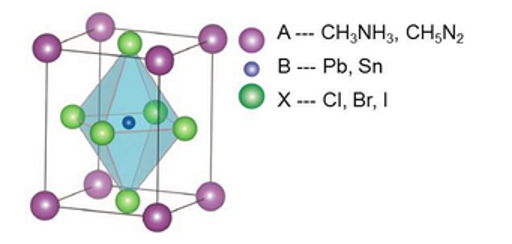
Structure of perovskite. A contains organic materials such as CH3NH3, B contains Pb, Sn, etc., and X contains I, Br, etc.
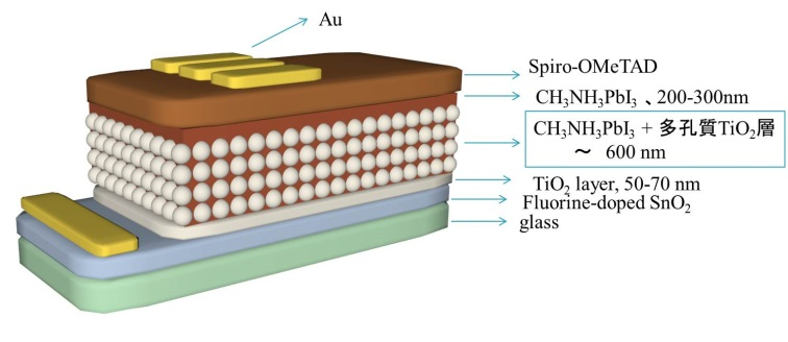
Structure of perovskite solar cells. It has a superstrate structure, with light incident from the glass substrate.
At academic conferences at the time, questions were raised about how such a solar cell—a hybrid of organic and inorganic materials—could be fabricated by coating and at such low temperatures and still have high efficiency. Some people even speculated that it involves special physical mechanisms that do not exist in conventional inorganic materials (such as silicon and CIS). Since I have been conducting device simulations of solar cells made of inorganic materials such as CIS for a long time, I thought I could explain through simulations and started conducting research on perovskites.
Numerous researchers in chemistry have shifted to research on perovskite solar cells, such as organic thin films and solar cells made of organic materials, but I have focused on inorganic solar cells, such as crystalline silicon and CIS solar cells. I started conducting research on perovskites in 2014 with experience in conducting simulations on practical operation of the solar cells and devices.
Selected for NEDO’s Green Innovation Project to study degradation mechanisms
Following this, under a project by the New Energy and Industrial Technology Development Organization (NEDO), I joined a team that specializes in the organic and chemical aspects of perovskite as an expert in solar cells made of inorganic materials. We worked on designing high-efficiency perovskites.
Being able to design for higher efficiency means clarifying the operating mechanism. Therefore, I thought that the next step would be to clarify the degradation mechanism, which is key to practical applications. We worked on simulation, outdoor demonstration evaluation, and accelerated testing with funding from NEDO’s Green Innovation Project (GI Project). The University of Tokyo, Kyoto University, and Ritsumeikan University are the only universities selected as direct recipients of the GI Project.

Manufacturing of perovskite solar cells by spin-coating (left), perovskite film formed (middle), heat generation analysis of crystalline silicon solar cells (right)
Rather than fabricating perovskite solar cells, we have been involved in the design and performance evaluation of solar cells as experts. Perovskite solar cells are considered to be high-performance at the laboratory level; however, they have degradation problems. Under the GI Project, we are working to understand the mechanisms of degradation, predict degradation, and explore methods to control it.
Can thin, lightweight solar cells made in Japan attachable to building walls be achieved?
I would like to explain why solar cells are regarded as having such high expectations.
In Japan, approximately half of the electricity generated by solar cells comes from mega-solar plants. In this method, electricity is generated by placing numerous crystalline silicon solar cells on a large area of land. Approximately 10% of the power is generated by placing crystalline silicon solar cells on house roofs that are relatively stable and can hold weight. The remainder comes from solar power plants, which are smaller than mega-solar plants.
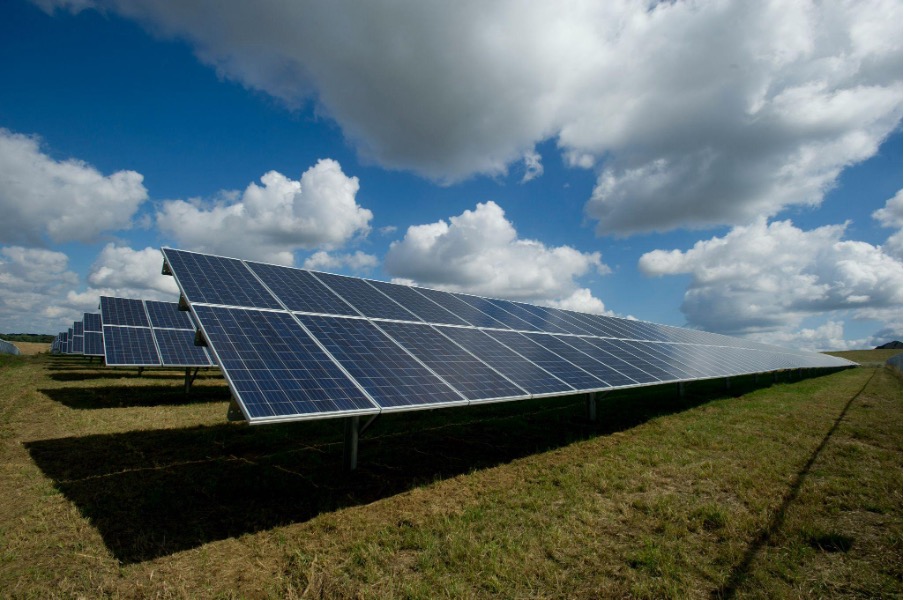
This means that the majority of solar cells in Japan are made of crystalline silicon and are installed in flat places capable of withstanding the weight.
Crystalline silicon panels are heavy, weighing approximately 11 kg per square meter. This means they cannot be placed where they cannot bear their weight. For example, corrugated metal roofs often used as factory roofs cannot bear weight in some cases and require lighter solar cells.
Another problem is the distance between solar power plants, such as mega-solar plants that generate electricity, and the land where there is an actual demand for electricity. It is said that it is better to integrate the demand and supply of electricity. However, while high-rise buildings in urban areas consume a lot of electricity, they have limited power generation on their rooftops, so it may be better to install solar cells on walls.
Thin and lightweight perovskite is anticipated as the next-generation solar cell because it allows solar cells to be attached to walls and other surfaces, which would be difficult for conventional crystalline silicon.
Perovskite solar cells have the same level of power generation efficiency as crystalline silicon in laboratory settings, and although the manufacturing cost is high, they can be fabricated simply by applying a coating. In the future, they may be produced at costs equal to or even cheaper than those of crystalline silicon.
With Japanese research and technology, we may be able to replace crystalline silicon with next-generation solar cells. Furthermore, iodine, which is the main raw material for perovskite solar cells, can be manufactured in Japan, so the government and government agencies are providing strong support to achieve made-in-Japan solar cells that can be used to supplement the domestic power supply and expand to the rest of the world.
A path to practical use without losing performance and durability
As a solar cell expert, I do not restrict myself to perovskite alone, but I believe it is an important technology, so I want to contribute to solving its issues, disseminating it, and putting it to use.
Amorphous silicon showed great promise in the past, and the government made large investment, but since the problem of degradation remained unsolved, it is not widely used. Regarding perovskite solar cells, I often hear that the surrounding players are more enthusiastic than the solar cell developers and experts, and that the situation resembles that of Amorphous silicon development.
After all, we need a method that maintains performance and durability, which is the current issue before perovskite, and achieve practical usage. Therefore, I believe that we need to make extensive use of the knowledge of researchers and experts.
For solar power generation, we also need to improve the safety and reliability of crystalline silicon and conduct research to avoid defects and hazards.
For example, when a leaf falls on to a solar cell and partially shades it, there are cases of the shaded area generating heat. Because heat generation can increase under certain conditions, we are also investigating the heat generation mechanism of new solar cells and how this can be avoided. Further, as an expert in solar power generation, I will research and spread information on the reuse and recycling of solar cells.
Driving Force behind the Venture Startup and YouTube Videos: “I want to broaden our horizons and expand the base of solar power generation”
Scholars Co. Ltd. Offers support to companies, mainly small and medium-sized enterprises, to successfully develop businesses related to solar power generation by judging technologies, developing them together, and providing consultations. We also have solar power researchers from other universities on our team.
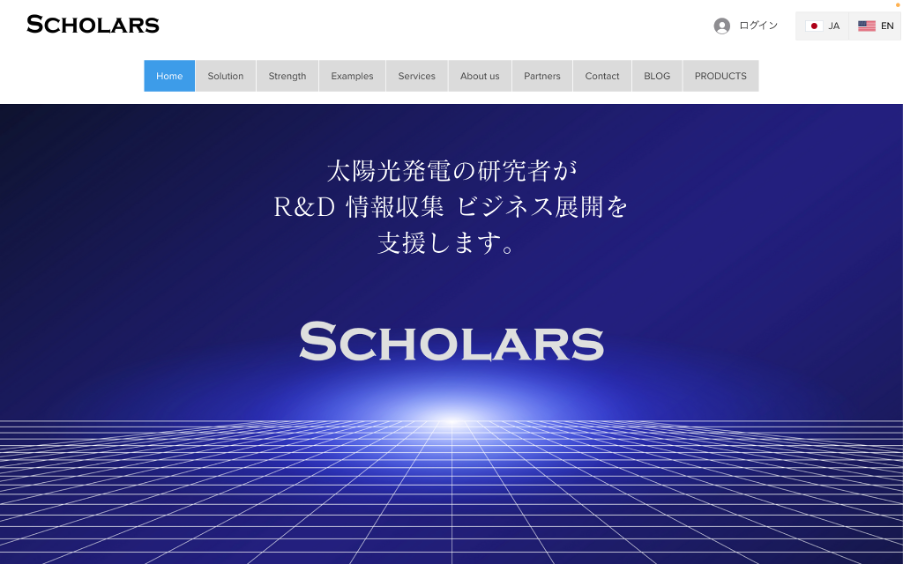
Scholars Co. Ltd. Website. A Ritsumeikan University venture established and led by Professor Minemoto.
As a university researcher, I often participate in projects with the government and large corporations, but I think it is important to engage with small and medium-sized enterprises to expand the scope of solar power generation and implement it in businesses and to expand my own horizons.
YouTube has various channels for solar power, but the PhotoVoltaics University channel provides in-depth discussions from professionals in the solar power field. I am committed to providing accurate and in-depth information to young researchers and individuals involved in corporate R&D and management.
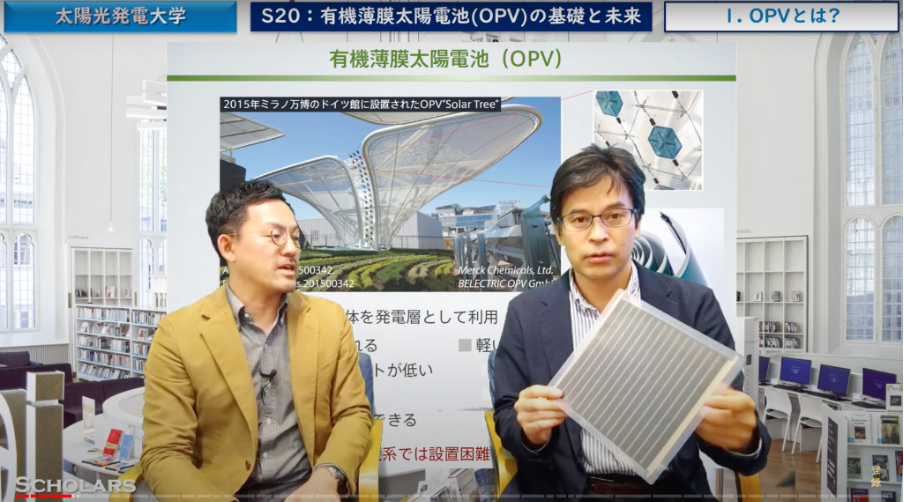
Episode of the YouTube channel “PVU -PhotoVoltaics University−太陽光発電大学” with guest speaker Professor Itaru Osaka of Hiroshima University
Going forward, in order to integrate solar cells into various places such as building walls, cars, and roads, and utilize them, we need to work with professionals in fields other than solar cells. I hope to expand the network for solar cells through YouTube.
I would also like to record my own conversations with professors from other universities regarding cutting-edge research. When I attend academic conferences, people often come up to me to say that they have watched my YouTube videos.
My aim is to make Ritsumeikan University a go-to for solar cells, and contribute to building a sustainable society.
As an expert in solar cells, I aim for solar power generation to become increasingly widespread in society and familiar to us in the future.
Perovskite solar cells are on an upward trajectory, but we will face many issues and problems in the future. Taking these issues into account, we need to make good use of solar power in society and make it sustainable. I want to engage in a wide range of activities so that Ritsumeikan University can become a go-to institution for solar cells.
The CO2 that humans have dug up, used, and scattered in the atmosphere must eventually be restored over hundreds of years and restore the Earth to its original state. I believe this is my intent, the intent of humanity, and surely, the will of Earth. One of the means to achieve this is solar power generation, so I will do everything that I can contribute to its progress and development.
As part of RARA, in addition to solar cells, I want to contribute to decarbonization by collaborating with professors specializing in energy storage (storage batteries, hydrogen, etc.).

